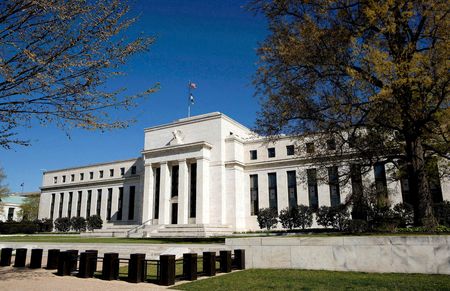By Gertrude Chavez-Dreyfuss
NEW YORK (Reuters) – Futures on the fed funds rate, which measures the cost of unsecured overnight loans between banks, have priced in a nearly 60% chance of a 50 basis-point rate cut by the Federal Reserve on Wednesday, LSEG calculations showed.
That was up from 45% last Friday and from 25% following the release of an in-line U.S. consumer price index report last week.
The Fed will hold a two-day policy meeting starting on Tuesday and is widely expected to reduce the benchmark overnight interest rate currently in the 5.25% to 5.50% range. The rate reduction, however, has turned into a coin flip between 50 and 25 bps over the last few days.
For 2024, rate futures have factored nearly 120 bps in easing, and about 250 bps in cuts by September of 2025.
Up until last Friday, the odds were pretty much tilted toward a 25-bp cut. But reports by the Wall Street Journal and Financial Times late Thursday saying a 50-bp rate reduction is still an option, and comments from former New York Fed President Bill Dudley arguing for an outsized cut, triggered a pivot in market expectations.
On Monday, Dudley reiterated his stance on the need for the Fed to do a big cut on Wednesday. In an opinion piece on Bloomberg News, the former Fed official noted that the Fed’s dual mandate of price stability and maximum sustainable employment has become more balanced, which suggests monetary policy should be neutral, neither restrictive nor boosting economic activity.
“Yet short-term interest rates remain far above neutral. This disparity needs to be corrected as quickly as possible,” Dudley wrote.
But whether the Fed goes 50 or 25 bps, Boris Kovacevic, global macro strategist at Convera in Vienna, said it does not really matter in the end “given the long lag and transmission mechanism, but it does matter in terms of how they want to be perceived.”
“If they go 50, there is chance that the Fed has some information that investors don’t have and that recession risks are more likely than currently anticipated and priced in.”
(Reporting by Gertrude Chavez-Dreyfuss; editing by Jonathan Oatis)












